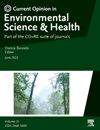Ecological dose-response curves against the clock
IF 6.6
Q1 ENVIRONMENTAL SCIENCES
Current Opinion in Environmental Science and Health
Pub Date : 2025-07-28
DOI:10.1016/j.coesh.2025.100653
引用次数: 0
Abstract
Dose-response curves are the basis for most public and environmental health decisions in ecology, environmental toxicology, pharmacology, and policymaking. Dose-response curves are often mistakenly assumed to be static in time. This gives rise to a major challenge in the field, correcting them for temporal variability. We review, here, evidence that there is unforeseen opportunity to predict temporal changes and that, by doing so, we might secure impactful progress in diverse disciplines such as ecotoxicology, conservation and restoration sciences, and precision agriculture. We develop a perspective on the steps that we need to take to realize this lost potential.
随时间变化的生态剂量-反应曲线
剂量-反应曲线是生态学、环境毒理学、药理学和政策制定中大多数公共和环境卫生决策的基础。人们常常错误地认为剂量-反应曲线在时间上是静态的。这引起了该领域的一个重大挑战,即根据时间变化对它们进行校正。在这里,我们回顾了一些证据,表明存在不可预见的机会来预测时间变化,通过这样做,我们可能会在生态毒理学、保护和恢复科学以及精准农业等不同学科中取得有影响力的进展。我们对需要采取哪些步骤来实现这一失去的潜力形成了一个视角。
本文章由计算机程序翻译,如有差异,请以英文原文为准。
求助全文
约1分钟内获得全文
求助全文
来源期刊

Current Opinion in Environmental Science and Health
Medicine-Public Health, Environmental and Occupational Health
CiteScore
14.90
自引率
0.00%
发文量
92
审稿时长
114 days
 求助内容:
求助内容: 应助结果提醒方式:
应助结果提醒方式:


